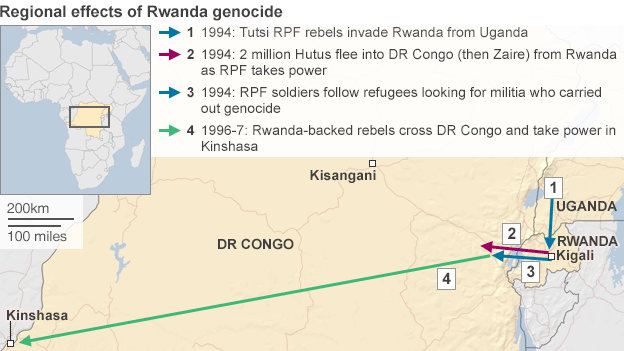MEMORIALISATION OF THE RWANDAN GENOCIDE
What Was the Rwandan Genocide?
"A genocide begins with the killing of one man — not for what he has done, but because of who he is. A campaign of 'ethnic cleansing' begins with one neighbour turning on another. Poverty begins when even one child is denied his or her fundamental right to education. What begins with the failure to uphold the dignity of one life, all too often ends with a calamity for entire nations." Kofi Annan, 2001.
Between April and June 1994, an estimated 800,000 Rwandans were killed in the space of 100 days.
Most of the dead were Tutsis - and most of those who perpetrated the violence were Hutus.
Even for a country with such a turbulent history as Rwanda, the scale and speed of the slaughter left its people reeling. The genocide was sparked by the death of the Rwandan President Juvenal Habyarimana, a Hutu, when his plane was shot down above Kigali airport on 6 April 1994. Hutu extremists blamed the Rwandan Patriotic Front (RPF) and immediately started a well-organised campaign of slaughter. The RPF said the plane had been shot down by Hutus to provide an excuse for the genocide.
How Was the Genocide Carried Out?
Lists of government opponents were handed out to the military who went and killed them, along with all of their families. Neighbours killed neighbours and some husbands even killed their Tutsi wives, saying they would be killed if they refused. At the time, ID cards had people's ethnic group on them, so militias set up roadblocks where Tutsis were slaughtered, often with machetes which most Rwandans kept around the house. Thousands of Tutsi women were taken away and kept as sex slaves.
Key Dates
-
6 April: President Habyarimana killed in plane explosion
-
April - July: Some 800,000 Tutsis and moderate Hutus killed
-
July: Tutsi-led rebel movement RPF captures the capital Kigali
-
July: Two million Hutus flee to Zaire, now DR Congo
There are now 8 official sites of memorialisation in Rwanda with hundreds more unofficial memorials, therefore this website will critically discuss key concepts surrounding memorialisation of dark sites with specific reference to those memorialising the Rwandan Genocide. Issues and consequences of such memorialisation will also be discussed.
Dark tourism is believed by some to be a difficult and often sensitive subject for many people and as a result this can make it difficult to acquire the desired attention from the mass consumer (Sharpley and Stone, cited in Kang and Lee, 2013).
Dark tourism is essentially 'heritage that hurts' and as such sites of dark events have become commercialised, and through presentation (whether this is real or fictional), death has become a commodity for consumption.
The Dark Tourism Spectrum & Memorialisation
The dark tourism spectrum was devised by Stone (2006) with an attempt to classify dark tourism sites as such sites are complex in design and diverse. This is because the term dark tourism is too broad to describe all sites so a model was required to define the varying shades of dark tourism products in terms of characteristics, traits and perceptions.
The darkest sites' usually exist in authentic locations of actual sites of death or within close proximity. These sites are generally ruins or remnants from historical or significant events yet still attract visitors and are typically education orientated for example, Auschwitz. 'The lightest sites' however, are purposefully created to provide tourism infrastructure. These sites lack authenticity and are usually created for entertainment purposes.
This spectrum can be useful in classifying memorials of dark tourism events as these are often the dark tourism attraction, for example the memorial gardens at Ground Zero and Hiroshima Peace Memorial Park in memorial of the Hiroshima atomic bombing.
It can be said that memorials at sites of genocide should be focused on educational and commemorative aims as opposed to negotiating tourism however many sites of genocide must face the reality that they will become popular tourist attractions (Friedrich and Johnson, 2013). With this in mind challenges arise for the memorialisation of genocide and Lennon and Foley (2000) state that the boundaries between education and commercialisation have become significantly blurred at such sites and as a result the commercialisation can result in a loss of authenticity.
Dark events can be memorialised through four main processes:
-
SANCTIFICATION
-
DESIGNATION
-
RECTIFICATION
-
OBLITERATION
Sancitifcation and designation will be discussed using case studies in relation to the various ways in which the Rwandan Genocide has been memorialised.




There are some notable limitations to this model, firstly it is difficult to state that every dark tourism site possesses the defining characteristics all of the time which can make it difficult to plot some sites on the spectrum. It can also be said that the experiences visitors experience define the attraction (Isaac and Cakmak, 2012). To further build on this point, Stone (2010) states that whilst many sites are multi layered, perceptions will be different amongst different groups of people. Also due to how dark tourism sites are supplied, this could mean such sites move along the spectrum, and are experienced differently by different people, Yang (2013) supports this by putting forward the idea that it is extremely difficult to measure the parameters within the dark tourism spectrum.